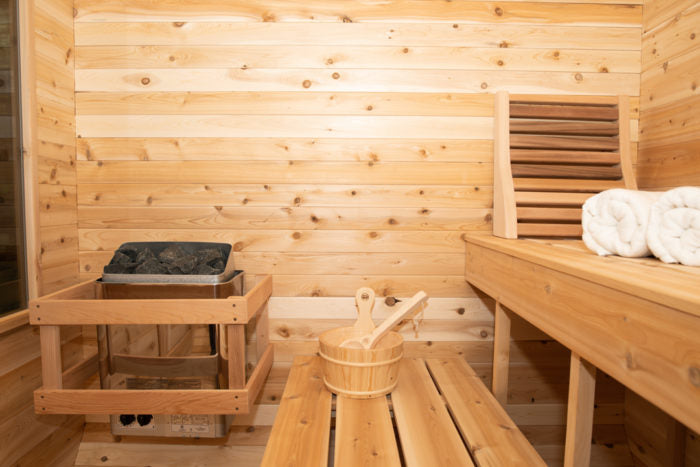The 45-Second Trick For Traditional Sauna
The 45-Second Trick For Traditional Sauna
Blog Article
Excitement About Traditional Sauna
Table of ContentsA Biased View of Traditional SaunaSome Known Incorrect Statements About Traditional Sauna Getting The Traditional Sauna To WorkTop Guidelines Of Traditional SaunaThe Ultimate Guide To Traditional Sauna
Many of the weight lost in a sauna is water loss and is re-gained upon rehydrating. However, without a question sauna can be a vital part of a healthy and balanced weight reduction program. To consider the distinctions between standard and IR saunas, I will certainly divide these right into proven, academic, and made differences.Therefore, the hottest factor in the saunawhich goes to the ceiling straight above the sauna heateris typically in between 185 and 190 F. Claims that a traditional sauna goes beyond 200 F is merely not real and not relevant for electrical saunas marketed in the United States. The temperature level for a far-infrared sauna is typically set in between 120 and 140 F; however, unlike the standard sauna, the goal in and IR space is not to achieve a heat.

When a conventional sauna has actually been appropriately heated, the sauna walls are cozy, the air temperature has achieved established temperature level and the rocks are super warmed. As a fascinating side note, the warmed wall surfaces and the rocks are emitting far-infrared warmth, combined with the heated air, to produce an "enveloping warmth".
Traditional Sauna - An Overview
When the high temperature is achieved, the aspects cycle on and off to keep the high temperature. Many typical sauna users appreciate pouring water over the rocks to develop steam to raise sauna moisture degrees. The benefits of pouring water over the rocks include: making the space more comfortable, dampening the nasal passages, and allowing the use of aromatherapy by mixing important oils with the water.

When the power gets in the body, it triggers the body temperature to enhance and eventually leads to sweating. In an infrared sauna it is essential for the emitters/heaters to stay on nearly constantly. Since there is no mass of rocks to maintain heat, the sauna will cool if the emitters turned off.
More About Traditional Sauna
As stated above, the sauna bather in an infrared room intends to place himself in front of running emitters to get optimal take advantage of the heat. The home heating time for both areas can be extremely different, depending pop over here upon how Resources the spaces are used. For a conventional sauna, a bather needs to enable 30-40 minutes for the space to achieve a preferred temperature and to correctly pre-heat the rocks.

A well constructed sauna will usually attain a temperature level of 150-160 F in concerning 30-40 mins (Traditional Sauna). For hotter temperature levels, the area may need to warmth for a longer duration. When the space achieves established temperature, the heater will certainly cycle on and off, usually running about 50% of the time. The insulated walls and the warmed rocks will keep the room hot and at secure temperature levels.
To some, 15 mins was "lost" while the infrared power warmed the wood panels rather than heating a body, while others discover a pre-heated room to be much more comfy and think an elevated starting temperature is required to begin perspiring. The size of recommended usage for every area is approximately the exact same (10-15 mins per session); nonetheless, due to view website the reduced air temperatures and the capability to really feel the effects of infrared heat quicker than a conventional sauna, it is not uncommon for a person to spend a total amount of 20-30 minutes in an infrared sauna.
The 6-Second Trick For Traditional Sauna

The typical price per kWH of power in the U.S. is approximately $0.11, so a 4.5 kW heating system will certainly set you back roughly $.50 to compete one hour, if the heating system runs continually for one hour. Commonly a sauna heater will run for 75% of the very first hour and 50% of subsequent hours on because the aspects cycle once the set temperature level is attained.
A 2 individual far-infrared room is typically physically smaller than a conventional sauna, usually about 4' x 4' or smaller sized. The IR heater is commonly 1.5-1.7 kW utilizing a 120 volt 15 amp plug-in service. Given that the room can be used faster than a sauna space, we will certainly assume the room is used for to of an hour including warm up time.
Lastly, there is a rarely discussed difference in the social experience between both spaces. While our culture has actually shed a few of the social benefit of the traditional sauna experience, it can be really socially gratifying (Traditional Sauna). From family members time in the sauna, to heart-felt conversations with better halves, to sauna partiesthe standard sauna experience can bring about intimate socializing
The smart Trick of Traditional Sauna That Nobody is Discussing
The majority of greater end infrared rooms consist of tinted light therapy, audio systems and full-glass fronts.
Report this page